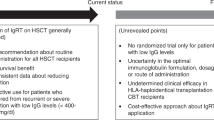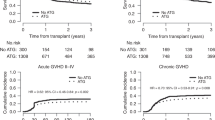Abstract
We evaluated the incidence and risk factors for hypogammaglobulinemia after allogeneic hematopoietic SCT (HSCT) in pediatric patients. Ig levels were measured pre-transplant, every 2 weeks until day 100 and then monthly post SCT in 185 patients undergoing myeloablative HSCT. Median age was 9 years; 142 (77%) had malignant disease and 114 (62%) received stem cells from an unrelated source. Hypogammaglobulinemia (IgG <500 mg/dL) developed in 143 (77%) of the patients at a median of 56 days (range 15–339) post SCT. The cumulative incidence of hypogammaglobulinemia at 1 year was higher among patients who developed acute GVHD (97% vs 54%, P<0.001), and for those receiving stem cells from an unrelated source (94% vs 51%, P<0.001). The cumulative incidence of TRM was significantly higher for patients with hypogammaglobulinemia (P=0.026). In multivariable analysis, lower pre-transplant IgG level (P<0.001), younger age (P=0.012), diagnosis of malignant disease (P<0.001), receiving unrelated SCT (P<0.001) and development of acute GVHD (P<0.001) were all significantly associated with higher risk of hypogammaglobulinemia post HSCT. We conclude that hypogammaglobulinemia is common, following allogeneic HSCT in pediatric patients, especially in those with malignant diseases, those who receive an unrelated transplant or patients who develop GVHD.
This is a preview of subscription content, access via your institution
Access options
Subscribe to this journal
Receive 12 print issues and online access
$259.00 per year
only $21.58 per issue
Buy this article
- Purchase on Springer Link
- Instant access to full article PDF
Prices may be subject to local taxes which are calculated during checkout


Similar content being viewed by others

References
Geddes M, Storek J . Immune reconstitution following hematopoietic stem-cell transplantation. Best Pract Res Clin Haematol 2007; 20: 329–348.
Storek J, Wells D, Dawson MA, Storer B, Maloney DG . Factors influencing B lymphopoiesis after allogeneic hematopoietic cell transplantation. Blood 2001; 98: 489–491.
Norlin AC, Sairafi D, Mattsson J, Ljungman P, Ringden O, Remberger M . Allogeneic stem cell transplantation: low immunoglobulin levels associated with decreased survival. Bone Marrow Transplant 2008; 41: 267–273.
Wils EJ, Cornelissen JJ . Thymopoiesis following allogeneic stem cell transplantation: new possibilities for improvement. Blood Rev 2005; 19: 89–98.
Storek J, Viganego F, Dawson MA, Herremans MM, Boeckh M, Flowers ME et al. Factors affecting antibody levels after allogeneic hematopoietic cell transplantation. Blood 2003; 101: 3319–3324.
Cordonnier C, Chevret S, Legrand M, Rafi H, Dhedin N, Lehmann B et al. Should immunoglobulin therapy be used in allogeneic stem-cell transplantation? A randomized, double-blind, dose effect, placebo-controlled, multicenter trial. Ann Intern Med 2003; 139: 8–18.
Feinstein LC, Seidel K, Jocum J, Bowden RA, Anasetti C, Deeg HJ et al. Reduced dose intravenous immunoglobulin does not decrease transplant-related complications in adults given related donor marrow allografts. Biol Blood Marrow Transplant 1999; 5: 369–378.
Howell JE, Gulbis AM, Champlin RE, Qazilbash MH . Retrospective analysis of weekly intravenous immunoglobulin prophylaxis versus intravenous immunoglobulin by IgG level monitoring in hematopoietic stem cell transplant recipients. Am J Hematol 2011; 87: 172–174.
Sheridan JF, Tutschka PJ, Sedmak DD, Copelan EA . Immunoglobulin G subclass deficiency and pneumococcal infection after allogeneic bone marrow transplantation. Blood 1990; 75: 1583–1586.
Sullivan KM, Kopecky KJ, Jocom J, Fisher L, Buckner CD, Meyers JD et al. Immunomodulatory and antimicrobial efficacy of intravenous immunoglobulin in bone marrow transplantation. N Engl J Med 1990; 323: 705–712.
Sullivan KM, Storek J, Kopecky KJ, Jocom J, Longton G, Flowers M et al. A controlled trial of long-term administration of intravenous immunoglobulin to prevent late infection and chronic graft-vs-host disease after marrow transplantation: clinical outcome and effect on subsequent immune recovery. Biol Blood Marrow Transplant 1996; 2: 44–53.
Acknowledgements
We would like to thank Alisha McCord for the administrative support. This project was supported by the Carolyn Perot Rathjen Chair in Pediatrics, Nashville, TN, USA (Haydar Frangoul).
Author information
Authors and Affiliations
Corresponding author
Ethics declarations
Competing interests
The authors declare no conflict of interest.
Rights and permissions
About this article
Cite this article
Frangoul, H., Min, E., Wang, W. et al. Incidence and risk factors for hypogammaglobulinemia in pediatric patients following allo-SCT. Bone Marrow Transplant 48, 1456–1459 (2013). https://doi.org/10.1038/bmt.2013.76
Received:
Revised:
Accepted:
Published:
Issue Date:
DOI: https://doi.org/10.1038/bmt.2013.76
Keywords
This article is cited by
-
Controversies about immunoglobulin replacement therapy in HSCT recipients with hypogammaglobulinemia
Bone Marrow Transplantation (2022)
-
Persistent hypogammaglobulinemia due to immunoglobulin class switch impairment by peri-transplant rituximab therapy
International Journal of Hematology (2020)
-
Therapeutic benefits targeting B-cells in chronic graft-versus-host disease
International Journal of Hematology (2015)
-
Risk factors for hypogammaglobulinemia after allo-SCT
Bone Marrow Transplantation (2014)


